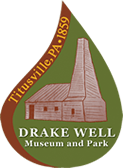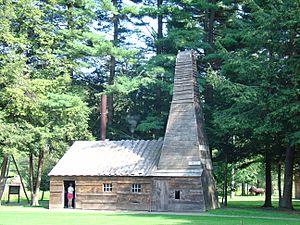Drake Well Museum facts for kids
 |
|

Replica Drake Well engine house and derrick
|
|
| Established | 1934 |
|---|---|
| Location | 202 Museum Lane, Titusville, Pennsylvania, U.S. |
| Type | Industry museum |
| Collection size | 4000+ |
| Visitors | 7,352 (2021) |
The Drake Well Museum and Park is a cool museum in Cherrytree Township, Pennsylvania. It tells the story of how the American oil industry began in 1859. This happened when Colonel Edwin Drake successfully drilled for oil. The museum keeps and protects many old items related to this important time.
At the museum, you can see a rebuilt version of the Drake Well. This well shows how people first used special drilling methods, like those for salt, to get petroleum (oil) from the ground. The museum is a historic place. It is located about 3 miles (4.8 km) south of Titusville. It sits between Pennsylvania Routes 8 and 27. The museum is officially recognized by the American Alliance of Museums.
Contents
What You Can See and Do
The Drake Well Museum and Park has lots of interesting things to explore. You can see a copy of the oil well that Colonel Edwin Drake drilled. There is also old oil field equipment that still works.
Inside the Museum
The museum has exhibits both inside and outside. Inside, you will find a library with over 2,500 books. There are also many old papers and more than 10,800 photos. You can watch an orientation film to learn about the museum. Guided tours are available, and there is a museum store too.
Special Events and Programs
The museum hosts fun events like the Fall Gas-Up engine show. They also have a spring Heritage Lecture Series. Schools can take special Heritage School Tours. A popular show is the Nitroglycerine Show, which explains how this powerful substance was used.
Nearby Places to Visit
Close to the museum, you can visit Oil Creek State Park. You can also ride the Oil Creek and Titusville Railroad.
New Exhibits to Explore
The State of Pennsylvania spent $8 million to update the museum. The new main exhibit is called "There's a Drop of Oil and Gas in Your Life Everyday." It features over 530 real items and many old pictures. You can hear stories about how the oil and gas industries started and grew. There are even interactive displays. One lets you hear a discussion between John D. Rockefeller and Ida Tarbell. She wrote a famous book called The History of Standard Oil.
How the Museum is Run
The Drake Well Museum and Park is managed by two groups. These are the Pennsylvania Historical and Museum Commission (PHMC) and the Friends of Drake Well, Inc. It used to be a Pennsylvania state park. Later, it was moved under the care of the PHMC.
Cool Exhibits to See
The museum has several amazing exhibits that show how the early oil industry worked.
Central Power Lease
This system was used to pump many oil wells at once with just one engine. A 20-horsepower Olin engine turns a special gear. This gear is connected to many long rods. These rods could go over or under roads to reach different wells. The engine has a unique sound from its exhaust pipe. This "barker" helped operators know it was still running from far away. This engine runs on natural gas and operates daily from May to October.
Drake Well Replica
The Drake Well replica was built in 1945. It is an exact copy of the engine house and derrick from the 1860s. The original building burned down in October 1859. It was replaced a month later. The museum used old photos taken by John A. Mather to make the copy perfect. A working copy of the steam engine was added in 1986. This engine pumps oil from the well from May to October. The oil used at Drake Well comes from McClintock Well #1. This well is near Rouseville and is the oldest oil well still working today.
Silver Run Pump Station
The National Transit Company built the Silver Run Pump Station in 1894. This company was made to manage pipelines for Standard Oil. The station worked in Franklin until 1968. Pennzoil gave it to the museum in 1981.
Visitor Center
The Visitor Center is where you can watch an orientation film. It also has the main exhibit, "There's a Drop of Oil and Gas in Your Life Everyday." You can also find a research library here. The center displays the Colonel Drake steam pumper from 1868. This pumper was from Titusville. You can also see a wagon like the one Mather used for his photographic process. The new exhibit also shows many more items, including John Wilkes Booth's cane.
History of Oil in Pennsylvania
Oil was known to be in the Oil Creek Valley of northwestern Pennsylvania. But for a long time, there was no good way to get it out of the ground. Before drilling, oil was mostly used as medicine for people and animals. It was also used to make early kerosene.
How Oil Drilling Started
In the late 1850s, the Seneca Oil Company sent its manager, Colonel Edwin L. Drake, to find a way to get more "Rock oil" from "Oil Creek." His company rented land just south of Titusville. This area was chosen because for hundreds of years, Native Americans had collected oil from the water near a natural oil seep. Even today, Oil Creek still has some natural oil seeps.
Drake tried many ways to get more oil. He even tried digging a deep hole by hand. But when the hole almost collapsed and hurt his workers, Drake decided to try drilling. Local water well drillers told him, "You cannot drill for Rock Oil." So, Drake had to travel over 90 miles (145 km) to New Kensington, Pennsylvania. There, he found and hired a salt well driller named William A. Smith in the summer of 1859. After many challenges, they finally drilled a successful oil well on August 27, 1859. This event is seen as the start of the modern oil industry, and it changed the world!
How Oil Was Moved Around
At first, Teamsters (people with horses and wagons) carried the oil to barges. These barges were filled and sent down Oil Creek to Oil City on the Allegheny River. From there, the oil was moved to steamships and sent to Pittsburgh.
In 1862, trains started to be used for transportation. The Oil Creek and Titusville Railroad was finished between Titusville and Corry. Here, oil could be moved to other larger train lines going east and west. By 1865, pipelines were built right next to the train tracks. This meant that teamsters were hardly needed anymore. The next year, the railroad line was extended south to Petroleum Centre and Oil City. The Union City and Titusville Railroad was built in 1865. It later became part of the Philadelphia and Erie Railroad in 1871. In the fall of that year, President Ulysses S. Grant visited Titusville to see the booming oil industry. The first oil pipeline was built in 1862. By the late 1860s, pipelines crisscrossed the entire oil region.
New Businesses Grew
Many other businesses related to oil quickly started in the area. Eight refineries were built between 1862 and 1868 just in the Titusville area. People also needed tools for drilling, so several iron works were built. Titusville grew very fast, from 250 people to 10,000 almost overnight. In 1866, it officially became a city. The first oil millionaire was Jonathan Watson, who lived in Titusville. He owned the land where Drake's well was drilled. This same land is now part of Oil Creek State Park and the Drake Well Museum.
Fires and Challenges
Fires were always a big worry around oil. One of the worst fires happened on June 11, 1880. It was called "Black Friday." Almost 300,000 barrels (47,700 m³) of oil burned after a lightning strike hit an oil tank. The fire lasted for three days before it was finally put out. The oil was worth $2 million, but thankfully, no one lost their life.
Another fire happened on June 5, 1892. Oil Creek flooded, and a tank of benzine (a type of fuel) overturned. The benzine caught fire, and in the explosions that followed, many people died. Another lightning strike in 1894 caused 27,000 barrels (4,300 m³) of oil to be lost in a fire. Oil production was highest in the late 1880s. It has gone down a lot since then, though other oil is still used for demonstrations at the museum.
See also
- List of petroleum museums
- Oil Region

